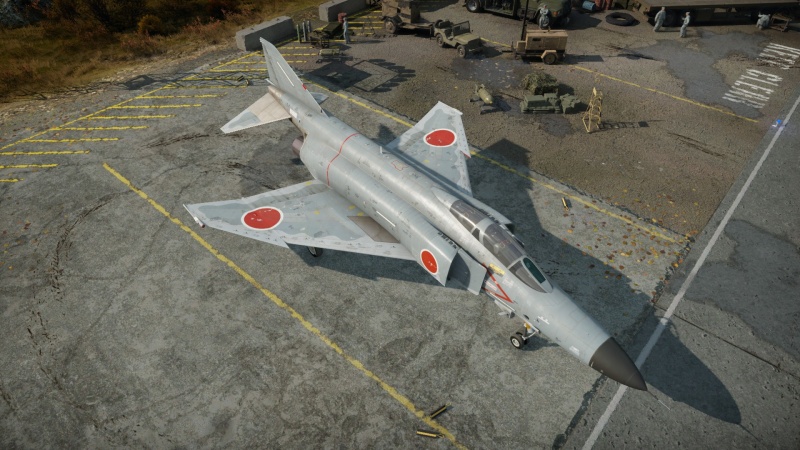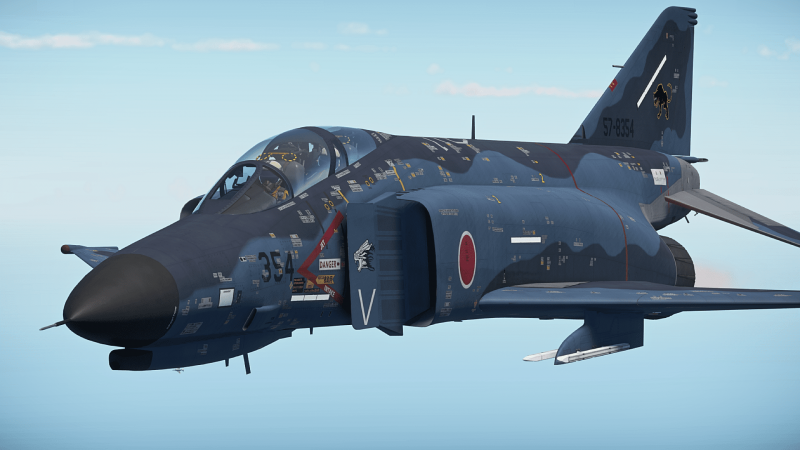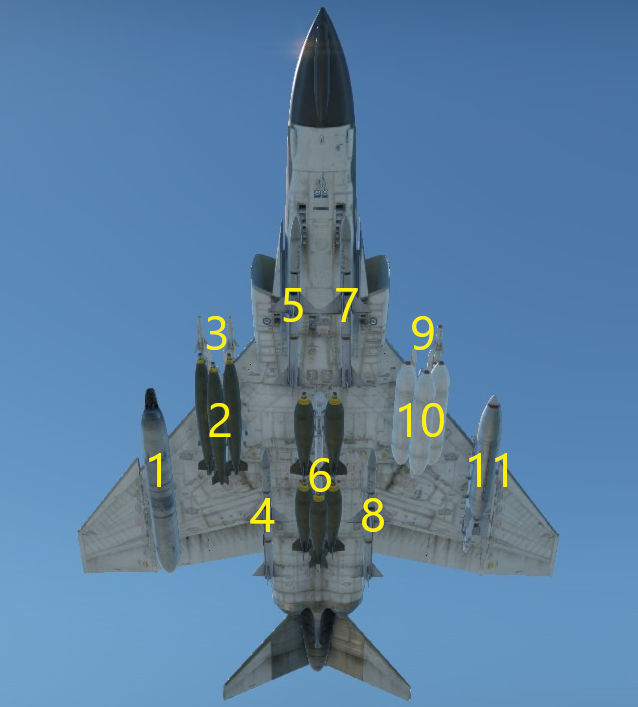Difference between revisions of "F-4EJ Kai Phantom II"
(Tag: Visual edit) |
(→Description) |
||
| (19 intermediate revisions by 9 users not shown) | |||
| Line 11: | Line 11: | ||
== Description == | == Description == | ||
<!-- ''In the description, the first part should be about the history of and the creation and combat usage of the aircraft, as well as its key features. In the second part, tell the reader about the aircraft in the game. Insert a screenshot of the vehicle, so that if the novice player does not remember the vehicle by name, he will immediately understand what kind of vehicle the article is talking about.'' --> | <!-- ''In the description, the first part should be about the history of and the creation and combat usage of the aircraft, as well as its key features. In the second part, tell the reader about the aircraft in the game. Insert a screenshot of the vehicle, so that if the novice player does not remember the vehicle by name, he will immediately understand what kind of vehicle the article is talking about.'' --> | ||
| − | The ''' | + | The '''F-4EJ Kai (F-4EJ改)''' was a crucial upgrade for the {{Annotation|JASDF|Japan Air Self-Defense Force}} to extend the operational life and enhance the combat capabilities of its domestically produced [[F-4EJ|F-4EJ Phantom IIs]], which were becoming outdated by the early 1980s. Initiated under the Aircraft Structural Integrity Program (ASIP), the modernisation effort began in 1980, with development taking place between 1981 and 1982, leading to its first flight in 1984. This upgrade introduced advanced radar and {{Annotation|FCS|Fire Control System}}, improved navigation and communication capabilities, and integrated modern missiles and bombing systems. A total of 90 F-4EJ Phantoms were converted to the F-4EJ Kai standard, enabling them to serve for an additional three decades until their decommissioning in 2021, with the last unit retiring under the [[F-4EJ ADTW|Air Development and Test Wing (ADTW)]]. |
| + | |||
| + | The '''F-4EJ Kai''' was introduced in [[Update "Direct Hit"]]. While it retains the classic [[F-4 Phantom II (Family)|F-4 "Phantom II"]] fuselage, it has been upgraded with 1990s technology to keep it relevant in modern combat. Notably, it shares the same PD radar, RWR, and weapon suite as the [[F-16 (Family)|F-16A "Fighting Falcon"]], making it a formidable opponent. To maximise its effectiveness, pilots should focus on using the AIM-7Fs for long-range engagements and head-on attacks while relying on the AIM-9Ls for quick kills in dogfights. However, it's crucial not to linger in close-quarters combat for too long, as more manoeuvrable jets can quickly gain the upper hand. Fire the missiles, secure the kill, and reposition before another opponent can sweep in. A more risky strategy involves intentionally slowing down the heavier F-4E airframe by making tight turns and using airbrakes, which can cause pursuing aircraft to overshoot. By flaring off incoming IR missiles and forcing the enemy into an overshoot, the F-4EJ Kai can get on the opponent's six, allowing it to finish them off with either an AIM-9 or a precisely calculated gun burst using its ballistic computer. This tactic, while dangerous, can turn the tables on unsuspecting adversaries who underestimate the F-4 by overestimating their own speed and missile capabilities. | ||
== General info == | == General info == | ||
| Line 120: | Line 122: | ||
{| class="wikitable" style="text-align:center" | {| class="wikitable" style="text-align:center" | ||
|- | |- | ||
| − | ! colspan=" | + | ! colspan="5" | [[Ballistic Computer]] |
|- | |- | ||
| − | ! CCIP (Guns) !! CCIP (Rockets) !! CCIP (Bombs) !! CCRP (Bombs) | + | ! CCIP (Guns) !! CCIP (Rockets) !! CCIP (Bombs) !! CCRP (Bombs) !! Lead indicator |
|- | |- | ||
| − | | {{Tick}} || {{Tick}} || {{Tick}} || {{Tick}} | + | | {{Tick}} || {{Tick}} || {{Tick}} || {{Tick}} || {{Tick}} |
|- | |- | ||
|} | |} | ||
| Line 134: | Line 136: | ||
The '''''{{PAGENAME}}''''' is armed with: | The '''''{{PAGENAME}}''''' is armed with: | ||
| − | + | * 1 x 20 mm JM61A1 cannon, belly-mounted (640 rpg) | |
| − | + | * 30 x large calibre countermeasures | |
| − | ** | + | * 60 x countermeasures |
=== Suspended armament === | === Suspended armament === | ||
{{Specs-Avia-Suspended}} | {{Specs-Avia-Suspended}} | ||
<!-- ''Describe the aircraft's suspended armament: additional cannons under the wings, bombs, rockets and torpedoes. This section is especially important for bombers and attackers. If there is no suspended weaponry remove this subsection.'' --> | <!-- ''Describe the aircraft's suspended armament: additional cannons under the wings, bombs, rockets and torpedoes. This section is especially important for bombers and attackers. If there is no suspended weaponry remove this subsection.'' --> | ||
| − | |||
| − | |||
| − | The '''''{{PAGENAME}}''''' can be outfitted with the following ordnance | + | The '''''{{PAGENAME}}''''' can be outfitted with the following ordnance: |
| − | |||
| − | |||
| − | |||
| − | |||
| − | |||
| − | |||
| − | |||
| − | |||
| − | |||
| − | |||
| − | |||
| − | |||
| − | + | {| class="wikitable" style="text-align:center" width="100%" | |
| − | {| class="wikitable | ||
|- | |- | ||
! !! width="4%" | 1 !! width="4%" | 2 !! width="4%" | 3 !! width="4%" | 4 !! width="4%" | 5 !! width="4%" | 6 !! width="4%" | 7 !! width="4%" | 8 !! width="4%" | 9 !! width="4%" | 10 !! width="4%" | 11 | ! !! width="4%" | 1 !! width="4%" | 2 !! width="4%" | 3 !! width="4%" | 4 !! width="4%" | 5 !! width="4%" | 6 !! width="4%" | 7 !! width="4%" | 8 !! width="4%" | 9 !! width="4%" | 10 !! width="4%" | 11 | ||
| − | | rowspan=" | + | | rowspan="13" width="30%" | <div class="ttx-image">[[File:Hardpoints_F-4C_Phantom_II.png]]</div> |
|- | |- | ||
| − | ! 20 mm GAU-4 cannons (1,200 rpg) | + | ! [[GAU-4 (20 mm)|20 mm GAU-4]] cannons (1,200 rpg) |
| 1 || || || || || 1 || || || || || 1 | | 1 || || || || || 1 || || || || || 1 | ||
|- | |- | ||
| − | ! 500 lb LDGP Mk 82 bombs | + | ! [[LDGP Mk 82 (500 lb)|500 lb LDGP Mk 82]] bombs |
| 6 || 3 || || || || 6 || || || || 3 || 6 | | 6 || 3 || || || || 6 || || || || 3 || 6 | ||
|- | |- | ||
| − | ! 750 lb M117 cone 45 bombs | + | ! [[Mk 82 Snakeye (500 lb)|500 lb Mk 82 Snakeye]] bombs |
| + | | 6 || 3 || || || || 6 || || || || 3 || 6 | ||
| + | |- | ||
| + | ! [[M117 cone 45 (750 lb)|750 lb M117 cone 45]] bombs | ||
| 3 || 3 || || || || 5 || || || || 3 || 3 | | 3 || 3 || || || || 5 || || || || 3 || 3 | ||
|- | |- | ||
| − | ! FFAR Mighty Mouse rockets | + | ! [[FFAR Mighty Mouse]] rockets |
| 57 || 57 || || || || 57 || || || || 57 || 57 | | 57 || 57 || || || || 57 || || || || 57 || 57 | ||
|- | |- | ||
| − | ! Zuni Mk32 Mod 0 ATAP rockets | + | ! [[Zuni Mk32 Mod 0 ATAP]] rockets |
| 12 || 12 || || || || 12 || || || || 12 || 12 | | 12 || 12 || || || || 12 || || || || 12 || 12 | ||
|- | |- | ||
| − | ! AIM-7E Sparrow missiles | + | ! [[AIM-7E Sparrow]] missiles |
| || || || 1* || 1* || || 1* || 1* || || || | | || || || 1* || 1* || || 1* || 1* || || || | ||
|- | |- | ||
| − | ! AIM-7F Sparrow missiles | + | ! [[AIM-7F Sparrow]] missiles |
| || || || 1* || 1* || || 1* || 1* || || || | | || || || 1* || 1* || || 1* || 1* || || || | ||
|- | |- | ||
| − | ! AIM-9L Sidewinder missiles | + | ! [[AIM-9L Sidewinder]] missiles |
| || || 2 || || || || || || 2 || || | | || || 2 || || || || || || 2 || || | ||
|- | |- | ||
| − | ! AIM-9P Sidewinder missiles | + | ! [[AIM-9P Sidewinder]] missiles |
| || || 1, 2 || || || || || || 1, 2 || || | | || || 1, 2 || || || || || || 1, 2 || || | ||
|- | |- | ||
| − | | colspan="12" | Maximum permissible loadout weight: 7, | + | ! 600 gal drop tanks |
| + | | || || || || || 1 || || || || || | ||
| + | |- | ||
| + | | colspan="12" | Maximum permissible loadout weight: 7,400 kg<br>Maximum permissible wing load: 3,000 kg<br>Maximum permissible weight imbalance: 1,500 kg | ||
|- | |- | ||
| colspan="13" | * AIM-7E and AIM-7F Sparrow missiles cannot be mixed, only one type may be equipped across hardpoints | | colspan="13" | * AIM-7E and AIM-7F Sparrow missiles cannot be mixed, only one type may be equipped across hardpoints | ||
|- | |- | ||
|} | |} | ||
| + | |||
| + | {{Navigation-Start|Default weapon presets}} | ||
| + | {{Navigation-First-Simple-Line}} | ||
| + | |||
| + | * 1 x 600 gal drop tank | ||
| + | * 2 x AIM-9P Sidewinder missiles + 2 x AIM-7F Sparrow missiles | ||
| + | * 4 x AIM-9P Sidewinder missiles | ||
| + | * 4 x AIM-9L Sidewinder missiles | ||
| + | * 4 x AIM-7E Sparrow missiles | ||
| + | * 4 x AIM-7F Sparrow missiles | ||
| + | * 3 x 20 mm GAU-4 cannons (1,200 rpg = 3,600 total) | ||
| + | * 24 x 500 lb LDGP Mk 82 bombs (12,000 lb total) | ||
| + | * 24 x 500 lb Mk 82 Snakeye bombs (12,000 lb total) | ||
| + | * 17 x 750 lb M117 cone 45 bombs (12,750 lb total) | ||
| + | * 285 x FFAR Mighty Mouse rockets | ||
| + | * 60 x Zuni Mk32 Mod 0 ATAP rockets | ||
| + | {{Navigation-End}} | ||
== Usage in battles == | == Usage in battles == | ||
<!-- ''Describe the tactics of playing in the aircraft, the features of using aircraft in a team and advice on tactics. Refrain from creating a "guide" - do not impose a single point of view, but instead, give the reader food for thought. Examine the most dangerous enemies and give recommendations on fighting them. If necessary, note the specifics of the game in different modes (AB, RB, SB).'' --> | <!-- ''Describe the tactics of playing in the aircraft, the features of using aircraft in a team and advice on tactics. Refrain from creating a "guide" - do not impose a single point of view, but instead, give the reader food for thought. Examine the most dangerous enemies and give recommendations on fighting them. If necessary, note the specifics of the game in different modes (AB, RB, SB).'' --> | ||
| − | + | ||
| + | The F-4EJ Kai is the ultimate Japanese package of the [[F-4 Phantom II (Family)|F-4 "Phantom II"]]. Equipped with the same pulse-Doppler radar as on the [[F-16 (Family)|F-16 "Fighting Falcon"]], the EJ Kai possesses the ability to use a fantastic radar for its airframe, battle rating, and missile arsenal to employ it in the best possible way, allowing it to quickly lock targets for AIM-9Ls and AIM-7Fs which can guarantee aerial kills above ~20 m ground clearance. | ||
| + | |||
| + | While the radar and cockpit avionics get a whole upgrade package (which greatly enhances its simulator capabilities due to its cockpit HUD), the airframe is still a Phantom II after all, lacking any real manoeuvrability without access to the "Agile Eagle" modification found on the American [[F-4E Phantom II]]. The F-4EJ Kai is, ultimately, a missile bus which hits hard. | ||
| + | |||
| + | As with all [[F-4 Phantom II (Family)|Phantom IIs]], the EJ Kai is a multi-role fighter with the capability to carry plenty of rockets, gun pods and bombs. However, due to it serving under the Japanese JASDF and its defensive doctrine, it lacks GBUs, AGMs, or Napalm bombs found on other (late) model Phantoms. While it is certainly possible to go multi-role, due to its large amount of carry capacity, it will turn its missile bus experience into a freight train towards bases or ground targets. This is only advised for quick carpet passes in ground battles or when trying to unlock later modules in air battles with priority towards AAMs, as the enemies facing the F-4EJ Kai won't have any issues intercepting a loaded Phantom. | ||
=== Pros and cons === | === Pros and cons === | ||
| Line 205: | Line 220: | ||
'''Pros:''' | '''Pros:''' | ||
| − | + | * Improved over the F-4EJ with better stock modifications. | |
| − | * | + | ** Starts with 2 x AIM-9Ps and 2 x AIM-7Fs instead of AIM-9Bs. |
| − | ** | + | ** Unlocks 4 x AIM-9Ps at Tier I without needing AIM-9Es. |
| − | ** 4 x AIM-9Ps | + | * Versatile armament options for various playstyles. |
| − | * | + | ** AIM-7F missiles offer long range, excellent manoeuvrability, and high G tolerance. |
| − | ** | + | ** AIM-9L missiles provide superior manoeuvrability, medium-long range, all-aspect tracking, and decent rear-aspect flare resistance. |
| − | ** | + | ** Can carry up to 8 missiles (4 IR, 4 SARH). |
| − | * | + | * Ballistic computer aids in aiming cannons, rockets, and bombs. |
| − | * | + | * Large supply of countermeasures. |
| − | * Large | + | * AN/APG-66 radar with advanced scanning, tracking modes, and strong resistance to notching and chaff. |
| − | * AN/APG-66 radar | + | * Advanced cockpit HUD for easy target tracking in simulator mode. |
'''Cons:''' | '''Cons:''' | ||
| − | + | * Limited ammunition for the frontal cannon. | |
| − | * Limited ammunition | + | ** Carrying additional gun pod(s) weigh down the plane considerably. |
| − | * | + | * No guided ordnance, reducing ground attack effectiveness. |
| − | ** | + | * Poor manoeuvrability and average acceleration/top speed, especially compared to typical opponents. |
| + | ** Lacks the Agile Eagle package (F-4E / F-4F), which would enhance maneuverability. | ||
== History == | == History == | ||
| − | <!-- | + | <!-- ''Describe the history of the creation and combat usage of the aircraft in more detail than in the introduction. If the historical reference turns out to be too long, take it to a separate article, taking a link to the article about the vehicle and adding a block "/History" (example: <nowiki>https://wiki.warthunder.com/(Vehicle-name)/History</nowiki>) and add a link to it here using the <code>main</code> template. Be sure to reference text and sources by using <code><nowiki><ref></ref></nowiki></code>, as well as adding them at the end of the article with <code><nowiki><references /></nowiki></code>. This section may also include the vehicle's dev blog entry (if applicable) and the in-game encyclopedia description (under <code><nowiki>=== In-game description ===</nowiki></code>, also if applicable).'' --> |
| − | + | Since the introduction of the Mitsubishi F-4EJ in 1968, it had been one of the cornerstones of the JASDF along with the F-104J and then later F-15J/DJ; but being a jet from the mid-1960s with inferior avionics and armaments to the latest Soviet jets also meant an extensive upgrade for the fleet of EJs was required. The plans for upgrading the 90 MHI-built F-4EJs which were still airworthy started in 1981 and the first retrofitted jet (07-8431) took to the skies in July 1984 and joined the JASDF in December. Upgrades included: | |
| − | |||
| − | |||
| − | |||
| − | + | * Installation of J/AYK-1 guidance system for AShM and unguided bombs | |
| + | * Replacing AN/APQ-120 with the latest AN/APG-66J with pulse-Doppler capabilities; J/AVQ-3 radar display and guidance system for SARH AAMs | ||
| + | * New J/ASN-4 digital INS navigation system | ||
| + | * New Kaiser Electronics HUD | ||
| + | * J/APR-6 RWR, AN/APX-76A IFF, and AN/ALQ-131 countermeasures | ||
| + | * HOTAS controls | ||
| + | * Lightning rods by the radome | ||
| + | * New fuel tanks | ||
| − | + | These features passed for the budgets of FY1987 and the upgrades for these jets finished by 1990. | |
| − | + | By the time F-15J/DJs and F-2s joined the JASDF in larger quantities, F-4EJs (including the recon variant, RF-4EJ) were starting to retire. On 17 March, 2021, the very last 3 F-4EJ (Kai)s of the JASDF (17-8301[4038], [[F-4EJ ADTW|47-8336]][M036] and 07-8431[M131]) retired from the Air Development and Test Wing (ADTW) in Gifu Airbase, Nagoya, bidding farewell of Phantoms in JASDF service. <ref>https://theaviationist.com/2021/03/17/japans-last-three-f-4ej-phantoms-have-just-flown-for-the-last-time/</ref> | |
| − | + | {{notice|'''07-8431 (EJ Kai)''' and '''17-8301 (the very first JASDF EJ)''' were also used for the sampling of the in-game representation of this jet as the developers and DMM announced for a trip to Gifu before their ultimate decommission.<ref>https://warthunder.dmm.com/news/detail/8612</ref>}} | |
| − | '' | ||
== Media == | == Media == | ||
| Line 245: | Line 264: | ||
* [https://live.warthunder.com/feed/camouflages/?vehicle=f-4ej_kai Skins and camouflages for the {{PAGENAME}} from live.warthunder.com.] | * [https://live.warthunder.com/feed/camouflages/?vehicle=f-4ej_kai Skins and camouflages for the {{PAGENAME}} from live.warthunder.com.] | ||
| + | |||
{{Skin-gallery|market|ugcitem_1001078|F-4EJ_Kai_37-8315.jpg|Camo "''Go For It!''"|market|ugcitem_1001158|F-4EJ Kai 77-8399.png|Camo "''50th Anniversary JSDF''"|market|ugcitem_1001276|F-4EJ 37-8322.jpg|Camo "''Good Bye Okinawa''"}} | {{Skin-gallery|market|ugcitem_1001078|F-4EJ_Kai_37-8315.jpg|Camo "''Go For It!''"|market|ugcitem_1001158|F-4EJ Kai 77-8399.png|Camo "''50th Anniversary JSDF''"|market|ugcitem_1001276|F-4EJ 37-8322.jpg|Camo "''Good Bye Okinawa''"}} | ||
| Line 253: | Line 273: | ||
;Related development | ;Related development | ||
| − | |||
* [[F-4 Phantom II (Family)]] | * [[F-4 Phantom II (Family)]] | ||
** [[F-4EJ Phantom II]] | ** [[F-4EJ Phantom II]] | ||
;Aircraft of comparable role, configuration and era | ;Aircraft of comparable role, configuration and era | ||
| + | {{columns|2| | ||
| + | * [[File:USA flag.png|30px|link=]] [[F-4 Phantom II (Family)]] (late / service-life extensions) | ||
| + | ** [[File:Israel flag.png|30px|link=]] [[Kurnass 2000]] | ||
| + | ** [[File:FRG flag.png|30px|link=]] [[F-4F KWS LV (Germany)|F-4F ICE]] | ||
| + | * [[File:NATO flag.png|30px|link=]] [[Tornado (Family)]] (ADV variants) | ||
| + | ** [[File:Britain flag.png|30px|link=]] [[Tornado F.3]] | ||
| + | ** [[File:Italy flag.png|30px|link=]] [[Tornado ADV]] | ||
| + | |||
| − | * | + | * [[File:Sweden flag.png|30px|link=]] [[SAAB 37 Viggen (Family)]] |
| − | * | + | ** [[File:Sweden flag.png|30px|link=]] [[JA37D]] |
| − | + | * [[File:France flag.png|30px|link=]] [[Mirage 2000 (Family)]] (2000C-series) | |
| + | * [[File:USSR flag.png|30px|link=]] [[MiG-23 (Family)]] | ||
| + | * [[File:China flag.png|30px|link=]] [[J-8 (Family)]] | ||
| + | }} | ||
== External links == | == External links == | ||
| Line 272: | Line 302: | ||
{{Manufacturer MHI}} | {{Manufacturer MHI}} | ||
{{Japan jet aircraft}} | {{Japan jet aircraft}} | ||
| + | <references /> | ||
Latest revision as of 18:20, 2 September 2024
| This page is about the Japanese jet fighter F-4EJ Kai Phantom II. For other versions, see F-4 Phantom II (Family). |
Contents
Description
The F-4EJ Kai (F-4EJ改) was a crucial upgrade for the JASDF to extend the operational life and enhance the combat capabilities of its domestically produced F-4EJ Phantom IIs, which were becoming outdated by the early 1980s. Initiated under the Aircraft Structural Integrity Program (ASIP), the modernisation effort began in 1980, with development taking place between 1981 and 1982, leading to its first flight in 1984. This upgrade introduced advanced radar and FCS, improved navigation and communication capabilities, and integrated modern missiles and bombing systems. A total of 90 F-4EJ Phantoms were converted to the F-4EJ Kai standard, enabling them to serve for an additional three decades until their decommissioning in 2021, with the last unit retiring under the Air Development and Test Wing (ADTW).
The F-4EJ Kai was introduced in Update "Direct Hit". While it retains the classic F-4 "Phantom II" fuselage, it has been upgraded with 1990s technology to keep it relevant in modern combat. Notably, it shares the same PD radar, RWR, and weapon suite as the F-16A "Fighting Falcon", making it a formidable opponent. To maximise its effectiveness, pilots should focus on using the AIM-7Fs for long-range engagements and head-on attacks while relying on the AIM-9Ls for quick kills in dogfights. However, it's crucial not to linger in close-quarters combat for too long, as more manoeuvrable jets can quickly gain the upper hand. Fire the missiles, secure the kill, and reposition before another opponent can sweep in. A more risky strategy involves intentionally slowing down the heavier F-4E airframe by making tight turns and using airbrakes, which can cause pursuing aircraft to overshoot. By flaring off incoming IR missiles and forcing the enemy into an overshoot, the F-4EJ Kai can get on the opponent's six, allowing it to finish them off with either an AIM-9 or a precisely calculated gun burst using its ballistic computer. This tactic, while dangerous, can turn the tables on unsuspecting adversaries who underestimate the F-4 by overestimating their own speed and missile capabilities.
General info
Flight performance
| Characteristics | Max Speed (km/h at 12,192 m) |
Max altitude (metres) |
Turn time (seconds) |
Rate of climb (metres/second) |
Take-off run (metres) | |||
|---|---|---|---|---|---|---|---|---|
| AB | RB | AB | RB | AB | RB | |||
| Stock | 2,255 | 2,221 | 16000 | 26.5 | 27.4 | 141.6 | 131.6 | 850 |
| Upgraded | 2,419 | 2,340 | 25.6 | 26.0 | 204.3 | 172.0 | ||
Details
| Features | |||||
|---|---|---|---|---|---|
| Combat flaps | Take-off flaps | Landing flaps | Air brakes | Arrestor gear | Drogue chute |
| X | ✓ | ✓ | ✓ | ✓ | ✓ |
| Limits | ||||||
|---|---|---|---|---|---|---|
| Wings (km/h) | Gear (km/h) | Flaps (km/h) | Max Static G | |||
| Combat | Take-off | Landing | + | - | ||
| 1458 | 463 | N/A | 580 | 463 | ~11 | ~4 |
| Optimal velocities (km/h) | |||
|---|---|---|---|
| Ailerons | Rudder | Elevators | Radiator |
| < 810 | < 750 | < 700 | N/A |
Engine performance
| Engine | Aircraft mass | |||||
|---|---|---|---|---|---|---|
| Engine name | Number | Basic mass | Wing loading (full fuel) | |||
| General Electric J79-GE-17 | 2 | 13,965 kg | 403 kg/m2 | |||
| Engine characteristics | Mass with fuel (no weapons load) | Max Takeoff Weight | ||||
| Weight (each) | Type | 9m fuel | 20m fuel | 30m fuel | ||
| 1,750 kg | Afterburning axial-flow turbojet | 15,724 kg | 17,787 kg | 19,829 kg | 24,000 kg | |
| Maximum engine thrust @ 0 m (RB/SB) | Thrust to weight ratio @ 0 m (WEP) | |||||
| Condition | 100% | WEP | 9m fuel | 20m fuel | 30m fuel | MTOW |
| Stationary | 5,200 kgf | 8,008 kgf | 1.02 | 0.90 | 0.81 | 0.67 |
| Optimal | 5,200 kgf (0 km/h) |
10,170 kgf (1,400 km/h) |
1.29 | 1.14 | 1.03 | 0.85 |
Survivability and armour
- 8.5 mm of Steel below the cockpit.
Modifications and economy
Armaments
| Ballistic Computer | ||||
|---|---|---|---|---|
| CCIP (Guns) | CCIP (Rockets) | CCIP (Bombs) | CCRP (Bombs) | Lead indicator |
| |
|
|
|
|
Offensive armament
The F-4EJ Kai Phantom II is armed with:
- 1 x 20 mm JM61A1 cannon, belly-mounted (640 rpg)
- 30 x large calibre countermeasures
- 60 x countermeasures
Suspended armament
The F-4EJ Kai Phantom II can be outfitted with the following ordnance:
| 1 | 2 | 3 | 4 | 5 | 6 | 7 | 8 | 9 | 10 | 11 | ||
|---|---|---|---|---|---|---|---|---|---|---|---|---|
| 20 mm GAU-4 cannons (1,200 rpg) | 1 | 1 | 1 | |||||||||
| 500 lb LDGP Mk 82 bombs | 6 | 3 | 6 | 3 | 6 | |||||||
| 500 lb Mk 82 Snakeye bombs | 6 | 3 | 6 | 3 | 6 | |||||||
| 750 lb M117 cone 45 bombs | 3 | 3 | 5 | 3 | 3 | |||||||
| FFAR Mighty Mouse rockets | 57 | 57 | 57 | 57 | 57 | |||||||
| Zuni Mk32 Mod 0 ATAP rockets | 12 | 12 | 12 | 12 | 12 | |||||||
| AIM-7E Sparrow missiles | 1* | 1* | 1* | 1* | ||||||||
| AIM-7F Sparrow missiles | 1* | 1* | 1* | 1* | ||||||||
| AIM-9L Sidewinder missiles | 2 | 2 | ||||||||||
| AIM-9P Sidewinder missiles | 1, 2 | 1, 2 | ||||||||||
| 600 gal drop tanks | 1 | |||||||||||
| Maximum permissible loadout weight: 7,400 kg Maximum permissible wing load: 3,000 kg Maximum permissible weight imbalance: 1,500 kg | ||||||||||||
| * AIM-7E and AIM-7F Sparrow missiles cannot be mixed, only one type may be equipped across hardpoints | ||||||||||||
| Default weapon presets | |
|---|---|
| |
Usage in battles
The F-4EJ Kai is the ultimate Japanese package of the F-4 "Phantom II". Equipped with the same pulse-Doppler radar as on the F-16 "Fighting Falcon", the EJ Kai possesses the ability to use a fantastic radar for its airframe, battle rating, and missile arsenal to employ it in the best possible way, allowing it to quickly lock targets for AIM-9Ls and AIM-7Fs which can guarantee aerial kills above ~20 m ground clearance.
While the radar and cockpit avionics get a whole upgrade package (which greatly enhances its simulator capabilities due to its cockpit HUD), the airframe is still a Phantom II after all, lacking any real manoeuvrability without access to the "Agile Eagle" modification found on the American F-4E Phantom II. The F-4EJ Kai is, ultimately, a missile bus which hits hard.
As with all Phantom IIs, the EJ Kai is a multi-role fighter with the capability to carry plenty of rockets, gun pods and bombs. However, due to it serving under the Japanese JASDF and its defensive doctrine, it lacks GBUs, AGMs, or Napalm bombs found on other (late) model Phantoms. While it is certainly possible to go multi-role, due to its large amount of carry capacity, it will turn its missile bus experience into a freight train towards bases or ground targets. This is only advised for quick carpet passes in ground battles or when trying to unlock later modules in air battles with priority towards AAMs, as the enemies facing the F-4EJ Kai won't have any issues intercepting a loaded Phantom.
Pros and cons
Pros:
- Improved over the F-4EJ with better stock modifications.
- Starts with 2 x AIM-9Ps and 2 x AIM-7Fs instead of AIM-9Bs.
- Unlocks 4 x AIM-9Ps at Tier I without needing AIM-9Es.
- Versatile armament options for various playstyles.
- AIM-7F missiles offer long range, excellent manoeuvrability, and high G tolerance.
- AIM-9L missiles provide superior manoeuvrability, medium-long range, all-aspect tracking, and decent rear-aspect flare resistance.
- Can carry up to 8 missiles (4 IR, 4 SARH).
- Ballistic computer aids in aiming cannons, rockets, and bombs.
- Large supply of countermeasures.
- AN/APG-66 radar with advanced scanning, tracking modes, and strong resistance to notching and chaff.
- Advanced cockpit HUD for easy target tracking in simulator mode.
Cons:
- Limited ammunition for the frontal cannon.
- Carrying additional gun pod(s) weigh down the plane considerably.
- No guided ordnance, reducing ground attack effectiveness.
- Poor manoeuvrability and average acceleration/top speed, especially compared to typical opponents.
- Lacks the Agile Eagle package (F-4E / F-4F), which would enhance maneuverability.
History
Since the introduction of the Mitsubishi F-4EJ in 1968, it had been one of the cornerstones of the JASDF along with the F-104J and then later F-15J/DJ; but being a jet from the mid-1960s with inferior avionics and armaments to the latest Soviet jets also meant an extensive upgrade for the fleet of EJs was required. The plans for upgrading the 90 MHI-built F-4EJs which were still airworthy started in 1981 and the first retrofitted jet (07-8431) took to the skies in July 1984 and joined the JASDF in December. Upgrades included:
- Installation of J/AYK-1 guidance system for AShM and unguided bombs
- Replacing AN/APQ-120 with the latest AN/APG-66J with pulse-Doppler capabilities; J/AVQ-3 radar display and guidance system for SARH AAMs
- New J/ASN-4 digital INS navigation system
- New Kaiser Electronics HUD
- J/APR-6 RWR, AN/APX-76A IFF, and AN/ALQ-131 countermeasures
- HOTAS controls
- Lightning rods by the radome
- New fuel tanks
These features passed for the budgets of FY1987 and the upgrades for these jets finished by 1990.
By the time F-15J/DJs and F-2s joined the JASDF in larger quantities, F-4EJs (including the recon variant, RF-4EJ) were starting to retire. On 17 March, 2021, the very last 3 F-4EJ (Kai)s of the JASDF (17-8301[4038], 47-8336[M036] and 07-8431[M131]) retired from the Air Development and Test Wing (ADTW) in Gifu Airbase, Nagoya, bidding farewell of Phantoms in JASDF service. [1]
| 07-8431 (EJ Kai) and 17-8301 (the very first JASDF EJ) were also used for the sampling of the in-game representation of this jet as the developers and DMM announced for a trip to Gifu before their ultimate decommission.[2] |
Media
- Skins
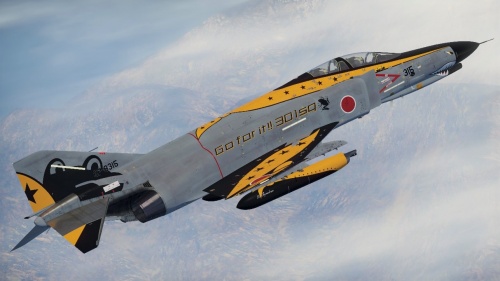
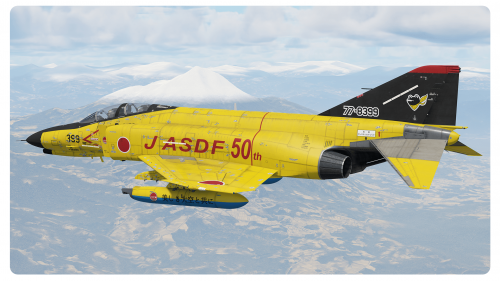
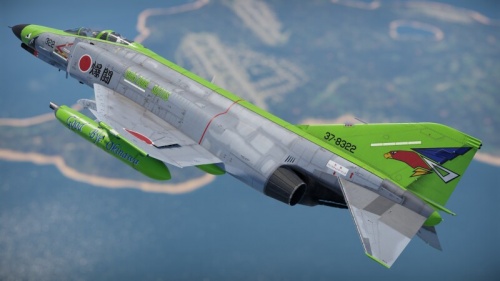
See also
- Related development
- Aircraft of comparable role, configuration and era
-
 F-4 Phantom II (Family) (late / service-life extensions)
F-4 Phantom II (Family) (late / service-life extensions)
-
 Tornado (Family) (ADV variants)
Tornado (Family) (ADV variants)
-
 SAAB 37 Viggen (Family)
SAAB 37 Viggen (Family)
-
 Mirage 2000 (Family) (2000C-series)
Mirage 2000 (Family) (2000C-series) -
 MiG-23 (Family)
MiG-23 (Family) -
 J-8 (Family)
J-8 (Family)
External links
| Japan jet aircraft | |
|---|---|
| IJNAS | |
| Experimental | Kikka |
| Reconnaissance | R2Y2 Kai V1 · R2Y2 Kai V2 · R2Y2 Kai V3 |
| IJAAS | |
| Fighters | Ki-200 |
| JASDF | |
| Fighters | F-86F-30 ▅ · F-86F-40 ▅ · F-86F-40 JASDF▅ |
| F-104J | |
| F-4EJ Phantom II · F-4EJ ADTW · F-4EJ Kai Phantom II | |
| F-15J · F-15J(M) | |
| F-16AJ | |
| F-1 | |
| Trainers | T-2 Early · T-2 |
| Foreign | |
| Thailand | ▄AV-8S · ▄F-5E FCU |



